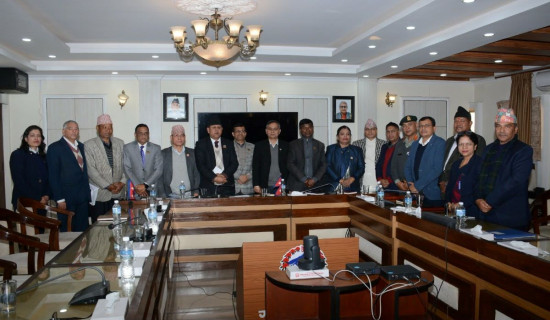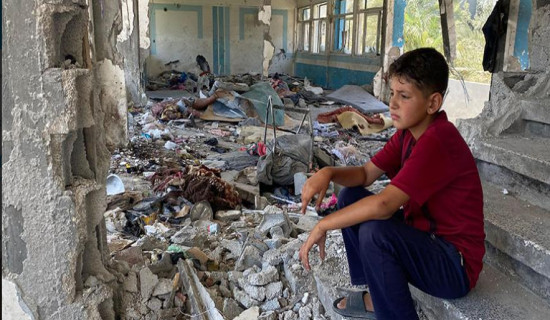- Monday, 5 January 2026
Consolidating Nepal-China Relations
Nepal and China established diplomatic relations on August 1, 1955. This year marks the 70th anniversary of formal diplomatic relations. During the last 70 years, bilateral relations have remained friendly, cordial and cooperative. Nepal-China relations, despite ups and downs, including major political changes in Nepal, continue to be based on friendship, cooperation and respect for sovereign equality of both countries. The history of Nepal-China relations dates back to ancient times when Chinese monks, pilgrims and scholars like Fa Xian and Hiuen Tsang and Nepali Buddhist scholar and artist like Buddhabhadra and Arniko, respectively, moved back and forth promoting cultural connectivity between the two countries. The marriage of Princess Bhrikuti of Nepal with Songtsen Gampo, King of Tibet, helped spread Buddhism in China.
As one of the five permanent members of the UN Security Council, China, which found its rightful place only in 1971, for which Nepal had raised its voice since its admission to the UN in 1955, has played a decisive role in world affairs and has championed the cause of inclusive and effective global governance. It has generously assisted in our development endeavours and supported the legitimate demands of the least developed among developing countries (LDCs) and land-locked developing countries (LLDCs) like Nepal.
Poverty alleviation
China has become prosperous today not only by modernising its economy through the open door policy but also by uplifting nearly 800 million people from abject poverty, a miracle indeed and a lesson for other developing countries grappling with the menace of poverty. China has helped uplift our socio-economic status from a land-locked to a land-linked country by agreeing to open up its seaports and dry ports for our transit trade and by further agreeing to link us with Trans-Himalayan cross-border railway connectivity, infrastructural and other development projects under the Belt and Road Initiative (BRI).
BRI, Chinese President Xi Jinping’s flagship project launched in 2013 immediately after he assumed office, aims to bring together all countries across the globe from Asia, Africa to Europe and Latin America on a common platform for concerted efforts to expedite common development and shared benefits through closer cooperation and larger connectivity in five different but related areas of infrastructure, trade, finance, environment and people-to-people contacts. The initiative evoked a positive response from more than 140 countries, including Nepal. BRI is expected to form a strong foundation for building a community of shared future for mankind. ‘The community with shared interests, shared responsibility and shared future’ is the key phrase China has been using to explain the underlying significance of BRI.
China understands well that the prosperity of a single country can never be sustainable. Therefore, while China is accelerating the speed of its unprecedented development efforts, it wants other countries in the world to rise and move forward. Ever since the initiative was announced, BRI has always been at the centre of discussion and debate in international forums. Certainly, attempts have been made to undermine its significance by forces opposed to a forward-looking proposal like BRI. The UN has recognised its potential to promote infrastructure development, connectivity and sustainable growth.
China has always respected the sovereignty, independence and territorial integrity of Nepal and has always helped Nepal during our hard times, like the 2015 earthquake and the COVID-19 pandemic. Nepal signed an MoU on BRI in 2017 and has since been participating in all BRI events hosted by China. BRI project is an opportunity for Nepal to boost its economy, in particular its infrastructure, which could lead, in the long run, to exponential development.
Signing of the Framework for Belt and Road Cooperation during Prime Minister KP Sharma Oli’s visit to China last December 2024 was a major step forward, as the implementation strategy endorsed by both sides has clarified some ambiguities and paved the way for effective and smooth implementation of BRI projects. The Framework primarily focuses on the infrastructural development of Nepal, enhancing connectivity between Nepal and China, potentially boosting bilateral trade and economic development. Bilateral agreement on expediting the feasibility study of Jilong/Keyrung- Kathmandu cross-border Railway has the potential to become a game-changer in Nepal-China cooperation. Effective implementation of infrastructural projects could enthuse Nepali youths going abroad to stay back and benefit from development opportunities at home.
The connectivity agenda agreed by Nepal and China could further contribute to enhancing bilateral and multilateral trade with other South Asian countries. BRI, as President Xi stated during his landmark visit to Nepal in 2019, could help Nepal accelerate its transformation from a landlocked country to a land-linked country. Xi's Nepal visit that took place after a gap of 23 years attracted a great deal of attention in our neighbourhood and the world at large, significantly contributed to promoting, strengthening and deepening relations between the two countries as well as giving a boost to Trans-Himalayan Connectivity Network which opened new possibilities for cross-border roads, railways, tunnels, economic zones, power sharing transmission lines, energy, tourism, education, health and environmental preservation. Much importance was attached to this visit, which, President Xi himself admitted, elevated Nepal-China relations to a new height, 'from a comprehensive to the strategic level of relationship in the new era.'
According to Chinese sources, the BRI project is not a fully grant-oriented programme. It is an initiative demanding that all parties or partners contribute for mutual benefits. It is a cooperative model of infrastructure development based on the win-win principle. During a meeting with PM Oli last year in Beijing, President Xi said that China respects Nepal’s choice to follow a development path suited to its national conditions. Policy inconsistency and bureaucratic hassles could slow down the implementation process. Besides, a lack of a specialised single authority for the implementation of projects might create complications
Chinese people want Nepalis to share development and prosperity of China. For Nepal, it is a good opportunity to uplift its condition aggravated by poverty, underdevelopment, brain drain and migration. The Chinese side, it is encouraging to note, is keen to accelerate the implementation of BRI projects already agreed upon as fast as possible. Nepal would do well to make the most of opportunities made available by China within the BRI framework to uplift people’s lives qualitatively so that Nepali people could feel proud of being citizens of a prosperous and happy country.
(The author is a former ambassador and an adviser to the China Study Centre.)





-square-thumb.jpg)











